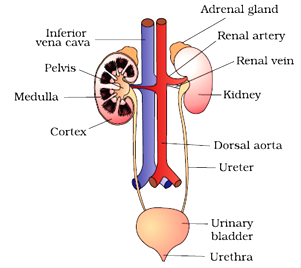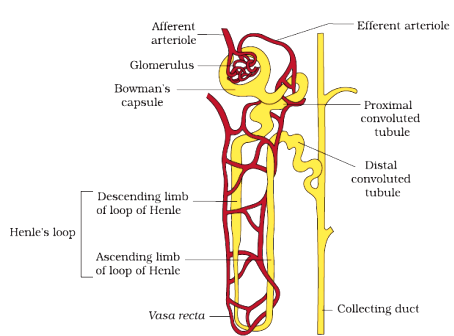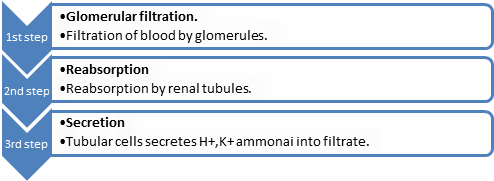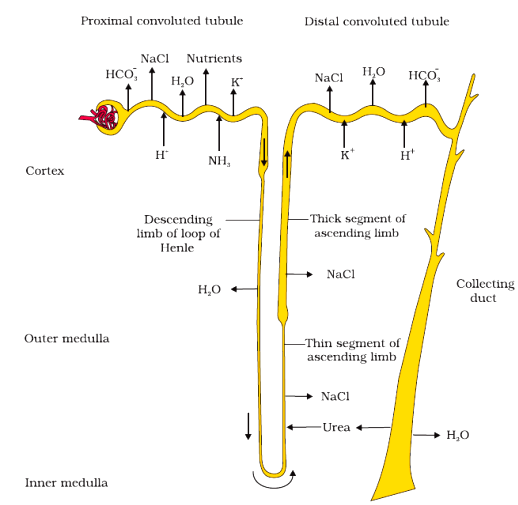CBSE Biology Chapter 19 Excretory Products and their Elimination class 11 Notes Biology in PDF are available for free download in myCBSEguide mobile app. The best app for CBSE students now provides Excretory Products and their Elimination class 11 Notes Biology latest chapter wise notes for quick preparation of CBSE exams and school based annual examinations. Class 11 Biology notes on Chapter 19 Excretory Products and their Elimination class 11 Notes Biology are also available for download in CBSE Guide website.
CBSE Guide Excretory Products and their Elimination class 11 Notes
CBSE guide notes are the comprehensive notes which covers the latest syllabus of CBSE and NCERT. It includes all the topics given in NCERT class 11 Biology text book. Users can download CBSE guide quick revision notes from myCBSEguide mobile app and my CBSE guide website.
Excretory Products and their Elimination class 11 Notes Biology
Download CBSE class 11th revision notes for Chapter 19 Excretory Products and their Elimination class 11 Notes Biology in PDF format for free. Download revision notes for Excretory Products and their Elimination class 11 Notes Biology and score high in exams. These are the Excretory Products and their Elimination class 11 Notes Biology prepared by team of expert teachers. The revision notes help you revise the whole chapter in minutes. Revising notes in exam days is on of the best tips recommended by teachers during exam days.
Download Revision Notes as PDF
CBSE Quick Revision Notes
CBSE Class-11 Biology
CHAPTER-19
Excretory Products and their Elimination class 11 Notes Biology
- Elimination of metabolic waste products from the animal body to regulate the composition of body fluids and tissues is called excretion. These waste products include ammonia, uric acid, urea, carbon dioxide and ions like , , Cl– and phosphates and sulphate.
- Ammonia is the most toxic and uric acid is the least toxic. The process of removing ammonia is called ammonotelism and organisms that excrete ammonia are called ammonotelic (bony fishes, aquatic amphibians and insects).
- The organism that release urea as nitrogenous wastes are called ureotelic (mammals, terrestrial amphibians). The organism that excretes uric acids is called uricotelic (reptiles, birds and land snails).
| Animals | Excretory organs |
| Flat worms, some annelids and cephalochordates. | Protonephridia or flame cells. |
| Earthworms and annelids | Nephridia |
| Insects including cockroaches | Malpighian tubules |
| Mammals | Kidney |
Human Excretory System
Human excretory system consists of:
- A pair of kidneys
- A pair of ureters
- A urinary bladder
- A urethra

- Kidneys are reddish brown bean shaped structure situated between last thoracic and lumber vertebra. Each kidney has a notch on its inner side called hilum through which ureter, blood vessels and nerves enter.

- Inside the hilum has broad funnel shaped space called renal pelvis with projection called calyces.
- Inside the kidney are two zone- outer cortex and inner medulla. Medulla is divided into medullary pyramids projecting into calyx.
- Cortex extends between medullary pyramids as renal column called Columns of Bertini.
- The functional unit of kidney is nephron. Each kidney contains about one million nephrons.
- Each nephron has two parts- the glomerulus and renal tubules. Glomerulus is the tuft of capillaries formed by afferent arteriole. Blood from glomerulus is carried away by efferent arteriole.
- Renal tubules starts with Bowman’s capsule continue with tubular parts divided into Proximal Convoluted tubules, Henle’s loop and Distal Convoluted tubule.

- The malpighian tubules, PCT and DCT of nephron are situated in cortical region where as loops of Henle’s into medulla.
| Juxta medullary Nephrons | Cortical Nephrons |
| a. Loop of Henle’s is short and extend only a little into medulla. | a. Loop of Henle’s are very long and extend deep into medulla. |
| b. The glomeruli lie close to the inner margin of the cortex. | b. The glomeruli lie in the outer cortex. |
Urine formation

- Glomerular capillaries blood pressure cause filtration of blood through 3 layers (endothelium of glomerular blood vessels, epithelium of Bowman’s capsule and basement layer between two membranes as ultra-filtration.
- The amount of filtrate formed by kidneys per minute is called glomerular filtration rate (GFR) which is 125 ml/minute.
- Glomerular Filtration rate is controlled by Juxta glomerular apparatus (JGA).
- 99% of filtrate has to be reabsorbed by renal tubules called reabsorption.
Function of Tubules
- Proximal Convoluted Tubules (PCT) – all the important nutrients, 70-80% electrolytes and water are reabsorbed.
- Henle’s Loop– maintains high osmolarity of medullary interstitial fluid.
- Distal Convoluted Tubules (DCT) – conditional reabsorption of Na+ and water. Maintains pH and sodium- potassium balance.
- Collecting Duct– large amount of water is reabsorbed to produce concentrated urine.
Mechanism of concentration of urine– The flow of filtrate in two limbs of Henle’s loop is in opposite direction to form counter current. The flow of blood in two limbs of vasa recta increase the osmolarity towards the inner medullary interstitium in the inner medulla.

- The transport of substance facilitated by special arrangement of Henle’s loop and vasa recta is called counter current mechanism.
Regulation of kidney function–
- Functioning of kidney is monitored by hormonal feedback mechanism of hypothalamus and JGA. Change in blood volume, body fluid and ion concentration activates the osmoreceptors in the body that stimulate the hypothalamus to release ADH or vasopressin hormones. The ADH facilitates water absorption in tubules.
- Decrease in glomerular blood pressure activate JG cells to release renin which converts angiotensinogen to angiotensin I and II that increase the glomerular blood pressure and release of aldosterone that increase absorption of Na+ ions and water.
Micturition – The process of expulsion of urine from the urinary bladder is called micturition. The neural mechanism that causes it is called micturition reflex. Urine formed in nephron is stored in urinary bladder till a voluntary signal is given by CNS. This initiates the contraction of smooth muscles of the bladder and simultaneous relaxation of the urethral sphincter causing the release of urine.
- Lungs, liver and skin also play important role in process of excretion. Lungs remove and water, liver eliminates bile containing substances like bilirubin, biliverdin. Sweat glands remove NaCl, small amount of urea and lactic acid. Sebaceous glands excrete sterol, hydrocarbons and waxes.
Disorders of Excretory System
- Uremia– there is high concentration of non-protein nitrogen (urea, uric acid, creatinine). Urea can be removed by hemodialysis.
- Renal failure– also known as kidney failure where glomerular filtration is ceased and both kidney stops working. Kidney transplant is the ultimate method in correction of acute kidney failure.
- Renal Calculi– formation of stone or insoluble mass of crystallized salts formed within the kidney.
- Glomerulonephritis (Bright’s Disease)-inflammation of glomeruli of kidney due to entry of protein or red blood corpuscles in to filtrate due to injury.
Excretory Products and their Elimination class 11 Notes
- CBSE Revision notes (PDF Download) Free
- CBSE Revision notes for Class 11 Biology PDF
- CBSE Revision notes Class 11 Biology – CBSE
- CBSE Revisions notes and Key Points Class 11 Biology
- Summary of the NCERT books all chapters in Biology class 11
- Short notes for CBSE class 11th Biology
- Key notes and chapter summary of Biology class 11
- Quick revision notes for CBSE exams
CBSE Class-11 Revision Notes and Key Points
Excretory Products and their Elimination class 11 Notes Biology. CBSE quick revision note for class-11 Mathematics, Physics, Chemistry, Biology and other subject are very helpful to revise the whole syllabus during exam days. The revision notes covers all important formulas and concepts given in the chapter. Even if you wish to have an overview of a chapter, quick revision notes are here to do if for you. These notes will certainly save your time during stressful exam days.
- Revision Notes for class-11 Physics
- Revision Notes for class-11 Chemistry
- Revision Notes for class-11 Mathematics
- Revision Notes for class-11 Biology
- Revision Notes for class-11 Accountancy
- Revision Notes for class-11 Economics
- Revision Notes for class-11 Business Studies
- Revision Notes for class-11 Computer Science
- Revision Notes for class-11 Informatics Practices
- Revision Notes for class-11 Geography
To download Excretory Products and their Elimination class 11 Notes, sample paper for class 11 Chemistry, Physics, Biology, History, Political Science, Economics, Geography, Computer Science, Home Science, Accountancy, Business Studies and Home Science; do check myCBSEguide app or website. myCBSEguide provides sample papers with solution, test papers for chapter-wise practice, NCERT solutions, NCERT Exemplar solutions, quick revision notes for ready reference, CBSE guess papers and CBSE important question papers. Sample Paper all are made available through the best app for CBSE students and myCBSEguide website.
- The Living World class 11 Notes Biology
- Biological Classification class 11 Notes Biology
- Plant Kingdom class 11 Notes Biology
- Animal Kingdom class 11 Notes Biology
- Morphology of Flowering Plants class 11 Notes Biology
- Anatomy of Flowering Plants class 11 Notes Biology
- Structural Organisation in Animals class 11 Notes Biology
- Cell Structure and Functions class 11 Notes Biology
- Biomolecules class 11 Notes Biology
- Cell Cycle and Cell Division class 11 Notes Biology
- Transport in Plants class 11 Notes Biology
- Mineral Nutrition class 11 Notes Biology
- Photosynthesis in higher plants class 11 Notes Biology
- Respiration in Plants class 11 Notes Biology
- Plant Growth and Development class 11 Notes Biology
- Digestion And Absorption class 11 Notes Biology
- Breathing and Exchange of Gases class 11 Notes Biology
- Body Fluids And Circulation class 11 Notes Biology
- Excretory Products and their Elimination class 11 Notes Biology
- Locomotion and Movement class 11 Notes Biology
- Neural Control and Coordination class 11 Notes Biology
- Chemical Coordination and Integration class 11 Notes Biology
- Cell Structure and Functions class 11 Notes Biology

Test Generator
Create question paper PDF and online tests with your own name & logo in minutes.
Create Now
Learn8 App
Practice unlimited questions for Entrance tests & government job exams at ₹99 only
Install Now